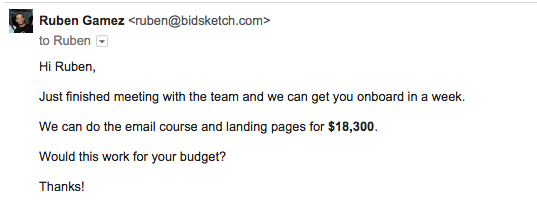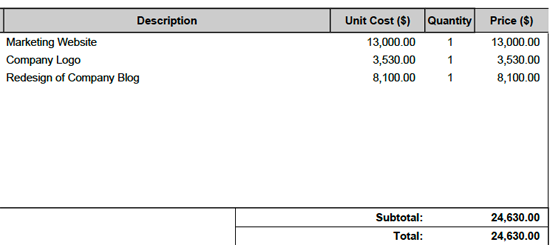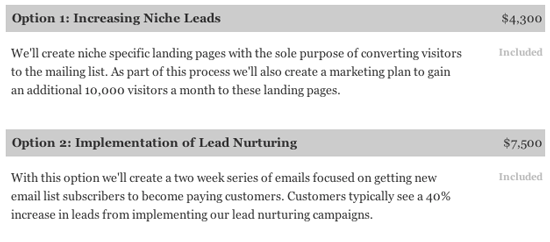5 Pricing Tips We Learned from 25,000 Proposals
The truth is that price rarely has anything to do with the quality of the service.
No, clients often pay a higher price for other reasons. Mostly it’s about what you offer, and how you’re offering it, that makes a difference.
Since Bidsketch is online proposal software, used by thousands of companies, we have access to sales and proposal data few people ever get to see.
We researched over 25,000 proposals (worth over $250M) to find out what’s working, and more importantly, why it’s working.
What we learned was both surprising and incredibly insightful. Keep reading to find out how dramatically close more deals, increase your rates, and charge what you’re really worth.
1. Standard Rates Are a Missed Opportunity
If two clients ask for the same service, do you charge them the same amount?
On the surface, it seems like it’s only fair to charge based on the work you’re doing. But when you dig deeper, it becomes clear that you should never do this.
Let’s make this concrete with an example:
What’s the value of a simple marketing campaign that increases new business by 30%?
It’s not what your competitor charges for a similar campaign, or the amount of time it took to create and execute. So why base the price on things that have nothing to do with the value?
Instead, you should base the price on what the results are worth to the client.
Each client who comes to you will get a different amount of value from your work. The price should be directly related to the amount of value you deliver.
Some good questions to ask:
- How will this project help your business?
- How will you know this project is successful for your business?
- What specific numbers will be affected (revenue, leads, etc.)?
- How much money is lost by not having this (or keeping the old one)?
You want to uncover the business needs behind the project and how much real value it’ll contribute. This way, you can make sure that you’re billing what you’re worth and can deliver enough value to end up with a happy client.
2. Bundle Your Pricing
Now, let’s talk about a way to present pricing to clients that was 36% more effective at closing deals than anything else in our research. I call it the bundled pricing technique.
But first, let’s discuss two common ways people provide project cost, and also the associated issues with them.
Emailing a Project Cost Estimate
Emailing the price estimate of the project is a popular way of telling the client how much the work will cost them:
Unfortunately, there are several problems with this approach if you want to close bigger deals.
Some of the obvious problems:
- The lack of professionalism and thoroughness sends the wrong signal
- If the email is short with little explanation, the price you sent can seem is arbitrary
- Emailed estimates are often automatically disqualified by larger companies
- There is absolutely no focus on the results/deliverables (it’s 100% about the price)
Invoice with an Itemization of Cost
Now let’s talk about the invoice-style estimate (another prevalent way of giving estimates):
There are also several problems with showing your fees this way.
To start with, you’re not telling your clients what value your services will provide for them. It’s hard to think about anything other than hours and price when looking at the above list.
You’re inviting the client to pick apart your estimate and go comparison-shopping to find a cheaper price.
There’s another problem: From a psychological standpoint, many studies have shown that people are more motivated to avoid losses than gains.
Loss aversion proposes that you’re likely to feel more pain by losing $100 than pleasure by gaining the same $100.
Going back to our invoice-style estimate, there’s a perceived loss in each line item when you show a price right next to it. That’s because:
Pain = Loss = Price
A Better Way: Bundled Pricing Technique
Alright, now that we’ve identified the things that we want to avoid, let’s look at what I think is a better way of presenting your fees:
The bundled pricing technique is one of the most effective ways of showing value when presenting your fees.
Below is an infographic about this technique by the startup I founded, Bidsketch (a web app for creating client proposals). Click below to see a bigger version of it.
Remember, the price is always going to be seen as a loss in your client’s mind. You can avoid focusing on the loss by bundling your fees into a single service with one price.
The key is to associate the price directly to the results your client wants (a single time).
The other critical part is to detail each service in the description area. Those services are what your client gains, so you want to show them off individually by unbundling the details.
3. Always Give Options
There’s a simple tactic you can use to increase your chances of getting a project and earn more revenue at the same time: Always give options.
If you present your client with a single option, you’re turning your service into a “yes/no” decision.
But when you give them three options instead of one, this changes the decision so they’re choosing the level of service instead.
They go from this:
“Should I hire this company for this price?”
To this:
“Which one of these will give me what I want for the right price?”
To make this work correctly, you need to make sure to follow some basic guidelines.
Take a look at what a good set of options looks like:
What kinds of results can you get from this? From our study of over 25,000 proposals and estimates, we found that one or two options result in 32% more revenue. That tends to happen because most people pick the middle option when presented with three options.
Some important guidelines:
- Pick options that enhance your base service: Think of your options as basic, enhanced, and premium options. Make sure they improve the service you deliver in some way.
- The price difference in options should be significant: You don’t want a small 10% price increase in each option. If your clients give you a budget, make one option significantly more than their budget.
- Options should contain a name, price and description: Make sure descriptions clearly communicate what the client will get by choosing that service. Focus on the business results instead of giving technical descriptions.
4. Never Decrease a Fee
A client will often say that the estimate is out of their budget. There are potentially two reasons for this:
- They may not feel the service they’re getting is worth the price (see the first tip about pricing according to value).
- They really can’t afford your services.
If they can’t afford what you’re offering, they may not be the right type of client for you.
On the other hand, if this project offers other benefits (maybe for your portfolio or introductions to other potential clients) and you’d like to work with them, you’ll likely be able to work something out as long as they have a reasonable budget.
Ask the client which service he wants to remove to lower the price. Never decrease the fee by itself just to work with a client; cut the amount of value they’ll receive instead.
You might be tempted to give a discount in this situation, but you’ll be undervaluing your work if you do so.
But that isn’t to say that you should never give a discount. You just have to…
5. Give Discounts the Right Way
There are times when a discount makes sense; you just want to be careful how you go about doing it.
There are two things to consider when giving a discount:
- Context
- Presentation
Context
Context is all about sending the right signal regarding what you’re worth and what behavior you want to encourage.
If you give a discount because someone is a new client, you’re starting the relationship on the wrong foot. You’ll have made a statement about what your time is worth and you’ve set a lower price anchoring that may be hard to change in the next project.
A better way is to give a discount if they pay everything upfront. This way you’re encouraging early payment and removing the risk of not getting paid later on.
Presentation
How you present the discount is the next thing you need to think about.
Take a look at these examples below:
Example 1:
Increasing Leads With a Landing Page – $10,000
– Includes 5% off Project for Early Payment
Example 2:
Increasing Leads With a Landing Page – $10,000
– Includes 75% off Social Media Marketing for Early Payment
Even if the discount is $500 in both cases, the second example will feel like a much better deal because it’s a larger percentage.
You can get this effect by discounting 75% off something of lower value — in the above example, let’s say that social media marketing costs $2,000 — instead of discounting 5% off the entire project.
So the rule is to discount something of lower value but make sure it’s for the right reason.
Putting it all Together
While any one of these pricing tips will work well alone, you’ll start earning what you’re really worth when you combine them together.
Remember what they are:
- Avoid using standard rates when possible.
- Bundle your fees into a single solution with a price.
- Give two or three options to avoid having a “yes/no” decision.
- Don’t decrease your fees without cutting down on the scope of the project.
- Give discounts for the right reasons and focus on the percentage.
Free Bonus: Perfect Proposal Pricing Template
Want to implement these tips in your proposals and estimates? Make sure you download the free pricing template below.
With it, you’ll quickly be able to implement:
- The bundled pricing technique for 36% more sales
- Discounting to improve your cashflow
- Optional fee upselling for 32% more revenue
You’ll also get tips on pricing, access to real case studies, and valuable information you can’t find anywhere else.






